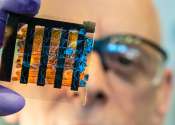Clever coating turns lampshades into indoor air purifiers
Indoor air pollution may have met its match. Today, scientists will report that they have designed catalyst-coated lampshades that transform indoor air pollutants into harmless compounds. The lampshades work with halogen ...
Aug 16, 2023
0
75









